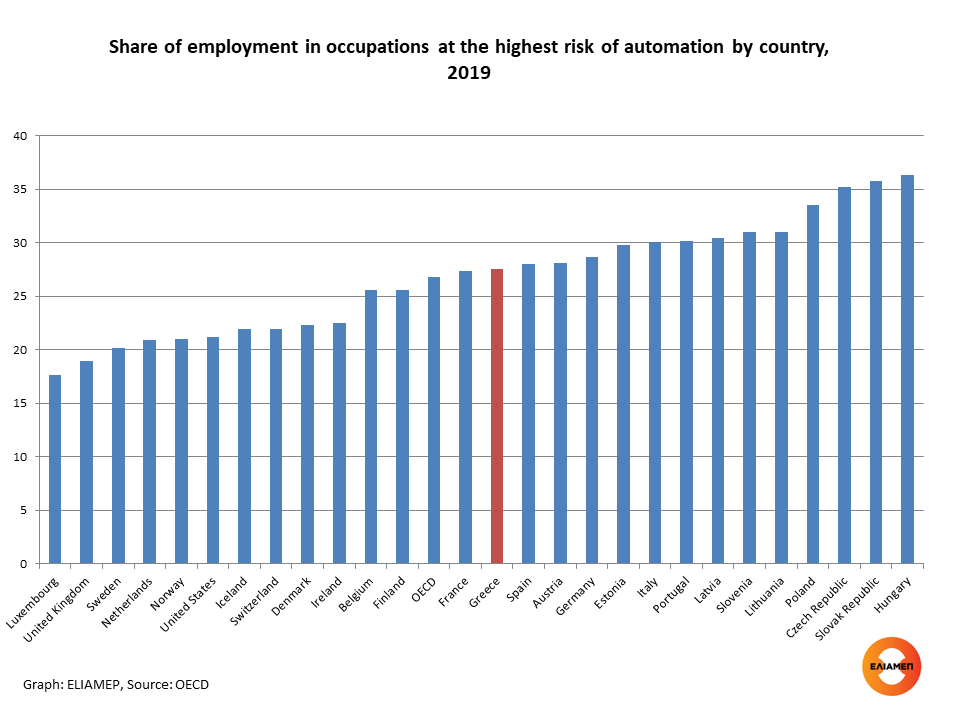The publication of the OECD’s Employment Outlook 2023revised the public debate regarding the impact of automation on the labor market. Taking into account new data, the report focuses on various automation technologies – e.g. robotics, artificial intelligence, etc. and identifies occupations at high risk of automation.
Across the 27 OECD member states for which data are available, occupations at highest risk of automation account for about 28% of employment. There are important differences between countries. In Hungary, Slovakia and the Czech Republic more than 35% of workers are employed in occupations at high risk of automation. In these countries, where a significant part of EU industry has been relocated, automation of manufacturing processes is taking place in order to increase competiveness. On the other hand, in Sweden, the United Kingdom and Luxembourg the percentage of total employment at risk of automation is equal to or less than 20%. In Greece the relative percentage is 27.6%.
The risk of automation does not necessarily imply permanent technological unemployment. Occupations at highest risk of automation will not necessarily be fully automated and disappear. In several instances, human work will be complemented by automated solutions.
It is not the first time that rapid technological changes have radically affected the labor market. For the past two and a half centuries, since the beginning of the Industrial Revolution, workers have been displaced from one industry and other workers (or even themselves) have found employment in another industry. For example, worldwide, more jobs were created in manufacturing than lost when agriculture was mechanised, and later more jobs were created in services than lost in manufacturing. Of course, this was often painful: historical research shows that e.g. in Britain wages recovered to their 1760 (pre-Industrial Revolution) level only in 1840.
In recent years, many middle-skilled occupations (e.g. machine operators, accounting assistants) have been easily automated because they are “routine based” following precise, predictable processes. In contrast, other occupations, whether highly skilled (e.g. researchers, business managers) or low skilled (e.g. carers, cleaners) were unaffected by automation. This has led to “job polarization”, with middle-skill (and middle-pay) jobs being replaced by other jobs at the top and bottom ends of the skills (and earnings) distribution.
Daron Acemoglu, a professor at MIT, has explained the mechanism by which innovative technologies raise productivity. First, the prices of goods and services whose production is automated decrease. Low prices then increase households’ purchasing power. Finally, the consumer spending that is saved is shifted to other goods and services throughout the economy, increasing the demand for labour producing them. At the same time, technological progress leads to the creation of new jobs in professions that did not exist. An estimated 60% of the 50 million jobs created between 1980 and 2015 in the US wereassociated with the additional employment growth in occupations with new job titles that did not exist in 1980. Clearly, the effects of technological change on employment depend not only on how many jobs are lost but also on how many new job positions are created.
But was this the case in the past? Is everything different this time? Will the rapid development of artificial intelligence lead to permanent technological unemployment for millions of workers?
A major difference of AI compared to previous technologies is that it threatens to automate even highly skilled jobs. On the other hand, the data shows that the demand for statisticians, software engineers, and other highly skilled workers has grown strongly recently.
Of course, older, low-skilled workers risk being left behind. Some countries have already invested in expanding formal education programs (e.g. Ireland), or launched initiatives to raise the level of AI skills in the population through vocational training and lifelong learning (e.g. Germany, Finland and Spain). The worrying thing is that for now the pace of policy response, in many countries including Greece, is not keeping up with the very rapid technological developments.
The challenge for public policy is on the one hand how to maximize the benefits and how to minimize the costs of technological change, and on the other hand how to fairly distribute benefits and costs. This translates into specific policy objectives. First, adjustments in regulatory and credit policy to facilitate the transition from declining or low-productivity economic activities to emerging, higher-productivity economic activities. Second, reforms in education and training to help workers develop the essential skills in order to take advantage of the new opportunities which will be created. Third, social protection reforms to support the income of those who are left behind, and those who leave occupations without a future to move to other occupations with more favorable prospects.




